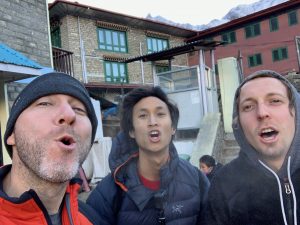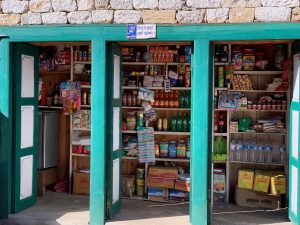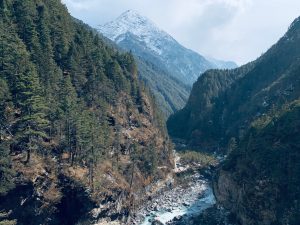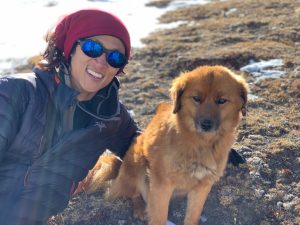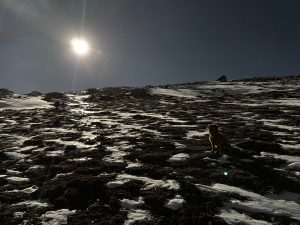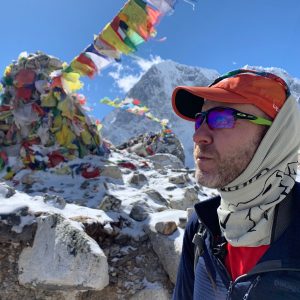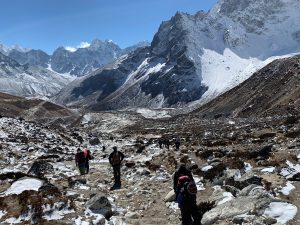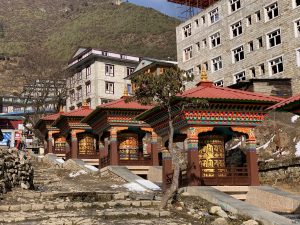Trekking to Mount Everest Base Camp Days 1-4
Mt Everest Base Camp: Trekking from Day 1 to Day 4
Over time we could withstand the cold and conquer the mountain
Most meaningful experience: Becoming one with our mountainous environment and the altitude is a powerful experience and I think why so many people strive to reach the summit. It is a feeling that is difficult to describe but about the energy within us all. Getting used to the cold (in fact enjoying it), as well as sharing the journey with friends who we laughed and danced with all the way.
Here is the blog from Day 5 to Descent. https://kdalive.com/trekking-to-everest-base-camp-day-5-descent/
Top tips:
- Train for the altitude by increasing your VO2 max
- Travel light but bring good hiking boots
- Book your trip in Kathmandu at one of the city’s 1700 travel agencies
- Practice deep breathing while on the mountain to get over altitude sickness
- Drink lemon, ginger and honey tea, as well as garlic soup to increase hydration
- If you want to make it, then no booze, no cigarettes, and no love!
Planning our trek in Kathmandu
It was almost 20 years ago when my friend asked me to hike Everest with him. At that time, it would have been drastically different from now. A hiker and porter had to carry everything with them, including food, tents, sleeping bags, and cooking gear. Today, the trekking route is lined with lodges from the Lukla Airport all way to the last stop before Everest Basecamp itself. I certainly would have been stronger 20 years ago but the amenities that are now on offer may have been worth the wait.
I’d arrived in Nepal with my friend Dan, an aspiring videographer who (like me) wanted to have an adventure before starting a new job. Planning the hike was surprisingly easy. There are around 1,700 tourist agencies in Kathmandu, so there’s no need to book before you go (and pay 2-3 times more). You can opt to fly to Lukla (at the start of the trek) independently and book lodges as you go or hire a guide and porter who will carry everything for you (around $20-50 per day). As we were there in the low season (and coldest season), the rates were really cheap, so we decided to hire a guide and a porter.
We stumbled upon Nepal Adventure whose office was lined with photos of people who had made it to EBC. The owner, Devi, had trekked to the base camp around 100 times and showed us a video shot 20 years ago by an Australian news outlet of him standing high up on the mountains. He explained that it was going to be challenging, not because of the terrain but because of the altitude and just how cold it was up there in February. He negotiated a deal for $1,000 each, which would include flights ($360 each), a guide, porter, accommodation and food. This was about $300 less compared to other agencies we visited and as we weren’t feeling so prepared to go it alone, we decided to book.
Day 1: Lukla to Phakding
When we arrived at the Kathmandu Airport, Dan got out of the car and projectile vomited, probably due to an undercooked chicken curry he ate the night before. As we passed through security, the guards wanted to know what was in his plastic bag, with Dan replying “this is my puke, it’s obviously safe”. I had to laugh.
Devi said his goodbyes to us, leaving us in the capable hands of our guide, Bhusan (who’d done the EBC trek 103 times) and our porter Suzan (an ice-climbing expert who had summited Everest three times). “Remember the three rules – no girls, no booze, no smoking – and you will make it to the summit”, he laughed as he left.
At the airport, we met Scott, a young guy who looked like a cross between a surfer and a hipster. He said he was “from California or Washington – somewhere around there”. We told him that we were planning on creating videos of the trek and he feigned ignorance but said he’d happily feature in them. But as soon as we passed the sacred gates of Lukla, he started giving us advice and told us he was a film major and had spent time working in Hollywood. Needless to say, he made a big difference to the videos!
Scott was wearing red board shorts and explained that Wim Hof had hiked Everest in one and he was going to do the same. We all shared an interest in Wim Hof’s “Iceman Method” and decided we would push the limits of cold weather and altitude training by hiking as much as we could without our shirts on and do push-ups/sit-ups every day. The locals thought we were crazy!
As we flew into Lukla Airport, we could see rolling mountains all around, with lodges lining the sides like ornaments on a Christmas tree. As we approached the runway, the mountains closed in on either side and we dropped right through the fog onto a slanted runway – the #1 most dangerous runway in the world!
It was about -3 degrees C when we alighted and we could see our breath clearly in the blue skies. My sinuses immediately felt the pressure and my hands quickly turned purple. It just reaffirmed what we already knew – the cold was going to be our biggest challenge.
We headed to the Buddha Lodge for lunch and met some older Aussies who hadn’t made it. They explained that it was unbearably cold, making it that much harder to breathe. We took their precautions seriously as we began the 65-kilometer-long trek to Everest Base Camp, with the first stretch taking us from Lukla to Phakding.
We stopped to buy a Samsung HD SIM card and soon realized that the towns along the route had everything. It made me wonder – were we hiking, “glamping” or in some kind of 21st-century Disney World?
We stopped every five minutes or so to take pictures, knowing that we’d become immune to the landscape’s beauty by the time we returned. I thought it was better to take pictures with a fresh eye and an untethered mind. Scott wasted no time in giving us tips, explaining various techniques for showing emotions and working in the “look over the shoulder” move.
As we arrived in Phakding, I was shocked to walk past a fully-stocked Irish bar with neon green lights inside and a foosball table. There were also small stores stocked with everything you’d find in a 7-11 back home – ramen, cookies, sodas, and toiletries.
That night we ate garlic soup, noodles, fried rice and omelettes, which would become our staples over the next few days, with the occasional meal of yak meat thrown in. There wasn’t much variation but it was ample nutrition. I soon learned that the lodges worked off a franchise system, so entrepreneurs could open their own with the same menu and lodgings.
That evening, we huddled around a cast iron stove with three young South Koreans who were fresh out of military training and were hiking as a treat to themselves. They were lighthearted and funny, explaining that the cold was nothing to them as they had to train in -40 degree C temperatures back home.
There were also three European girls from Ireland, Finland and Lithuania who said they hadn’t done much training for the hike but weren’t worried. After a couple of hours of small talk and journalling around the fire, the conversation came to an abrupt end when we questioned one of the guides about Nepal’s Communist government and whether they would honor the elections when the time came. One of the girls suddenly piped up with: “But you have Trump!” to which I put my head in my book and let Scott work his way out of.
Day 2 to 3: Phakding to Namche Bazaar
The following morning, we began the walk to Namche Bazaar, which was about 22km and wasn’t particularly difficult until the end. We crossed several bridges that connected the slopes of soaring mountains, evoking a myriad of feelings – the fear of falling, sheer awe at the scenery we were passing through and disbelief at how they got the metal ropes from one side to the other to hoist the bridges up.
We strolled through numerous villages and stopped at the home of Suzan’s sister for a bowl of garlic soup and cup of lemon honey tea (our major source of hydration) – both of which were phenomenally rejuvenating. The trail took us along a dirt road that hugged the mountains, passing stupas with prayer flags waving in the wind.
Then after one final turn, the magnificent town of Namche Bazaar came into view, with more than 100 colorful houses clustered on the side of the mountain. A large fountain ran through the town and spun a series of large prayer wheels. It was a sight I never expected to see and an architectural wonder.
We stayed in a lodge halfway up the mountain called Lukla Numbur, which was run by a really sweet lady who was the same age as me – 43. The lodge centered around a central dining area where everyone mingled, picnicked and napped on the benches.
I took a cold water bucket shower that reminded me of being in Africa….except that it was freezing cold outside! I thought it would be my last shower on the trek but one of the surprising effects was that the cold water acclimatized my body to the cold outside and I ended up feeling a lot warmer. After the shower, Bhusan look at me “a little bit cold?” he asked laughingly. “A little?” I responded but then I thought, it was only a little bit cold for him. Now that’s perspective. Or maybe it’s just the way he spoke – I couldn’t figure out which. The Nepalese add a little bit in front of everything that they want to exaggerate as being a lot. Check out the little bit cold video on Day 3.
The wooden rooms felt warm and cozy, that was until the sun went down. That’s when I got the first twinge of altitude sickness. My sinuses were feeling the pressure and my brain was racing in Japanese (something that often happens when I get to high altitudes). I knew I had to hydrate.
As we started our journals, I glanced over at Dan. He was writing quickly and looking much better – I knew he would be fine from here on. At every stop, they were feeding him raw garlic and garlic soup. As he walked past me to go to the bathroom, I noticed that he was starting to acquire a certain garlic-ly odor and chuckled to myself.
The altitude was also affecting my dreams. I dreamt of a scorpion walking over my face and it started my heart racing. I woke in a panic that night, went to the bathroom, then returned to sleep somewhat relieved.
The following day, we took a short hike for a few hundred meters in elevation to acclimatize, then just hung out in Namche. There were coffee shops, small convenience stores, and bakeries, as well as places named after Western shops like Walmart, Ben and Jerry’s, and even a North Face store. The other hikers were scattered around the town, reading books, drinking tea, and chatting. It was a contemplative atmosphere that got me thinking more about what I wanted to accomplish with my blog and the videos that Dan and I were creating.
“Kurt, we need an angle, something different,” he said. I explained that I wanted the blog to revolve around happiness and wellbeing, and felt that there was tons of potential in the Himalayas. “It’s about the mental, emotional and physical state – kindness, gratitude, connection. Being in good shape physically but also connected to your body emotionally”. We left it at that, agreeing to think about it more and search deeper about the ideas we’d discussed.
That evening, the locals were playing a badminton game outside of our lodge which created a lighthearted mood. We’d met a few Chinese hikers that day and stumbled upon a group of Koreans who were having a feast. Each person had hired a donkey to carry all of their food so they could recreate Korean delicacies along the trek. I wondered the price of such a journey.
From Namche Bazaar to Everest Base Camp was only 33 kilometers but with the cold and altitude already proving challenging, I was anxious about the days that lay ahead.
Day 4: Namche Bazaar to Tengboche
That night I woke with my heart racing. I remembered that being at altitude can significantly increase your blood pressure and heartbeat. Although my watch didn’t say it, I could definitely feel it.
As we began the ascent from Namche Bazaar to Tengboche, the dirt trails started transforming with a layer of snow and ice, reflecting the decrease in temperature and increase in just how cold the air around us really was. We passed lots of sherpas carrying up to 100 kg loads on their backs and learned that they were paid about $1-2/day to do so.
We met a young Chinese couple in their early 20s who had met online through a hiking group and decided to do the EBC trek together. The guy wasn’t going to make it and was preparing for a helicopter ride back to Kathmandu while the girl, Irene, wasn’t showing any signs of difficulty or being out of breath. She seemed completely at ease and super easy going about the situation she was in. Irene would later help me hammer out the messaging of my blog, just one of the many people we met who offered their ideas.
We also came across a really strong and hefty Iranian guy who was hiking alone and two Americans who were winging it – one who hiked the entire trip in jeans, a hooded sweatshirt, and some laced-up high tops. We encountered him again on the way back down and he spent an hour talking about what a waste of a vacation it had been when he could have just been relaxing on a tropical beach somewhere. I chuckled and congratulated him on a well-deserved feat. But the majority of people we saw coming down said it was worth, despite being incredibly cold. They were coming down hastily….and normally heavily clothed!
Keep reading here since feature post will cut off. Otherwise, keep going below.
By the time we reached Tengboche, a small village surrounded by mountains, we were all pretty exhausted. So Dan got us going on Wim Hof breathing to help us all calm down. It was here that we met Sophie, a Dutch girl who’d been left temporarily by her marathon-running boyfriend Jellen as he’d trekked ahead to check out another hut. He was about 6 feet 4 inches and 150 lbs, wearing only a single fleece he picked up in Kathmandu for the entire trek. I, on the other hand, was wearing two or three jackets at all times. Sophie had spent two months working in an orphanage and could speak Nepalese and sign language. She had amazing energy and laughed at all my jokes. When she asked to join us, we said “sure”. Later we also met up with her boyfriend who was a nice addition to our group, even with his sarcasm.
By the time we arrived at our hut in Tengboche, everyone was in good spirits and we got in another mini-workout. We then took our Wim Hof training to another level by doing the ice bucket challenge in sub-freezing temperature. The locals thought we were crazy, sending our videos viral around Nepal.

